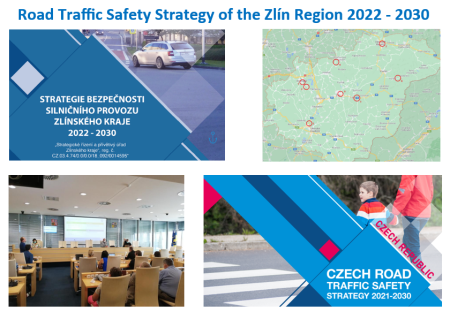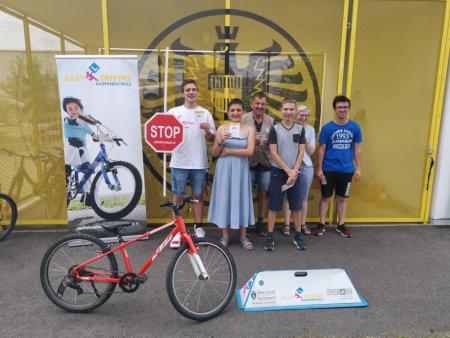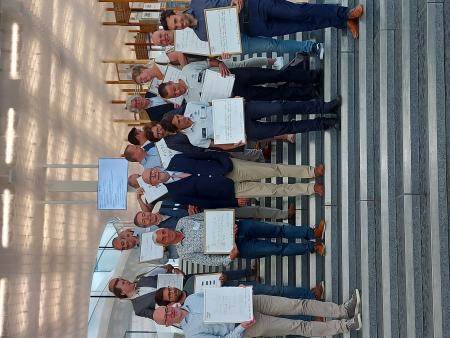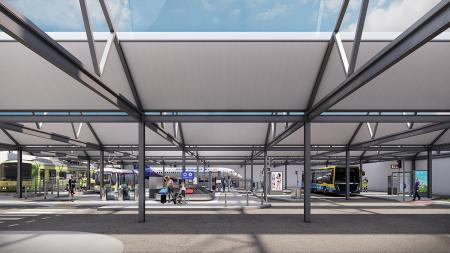Our members are dedicated to improving road safety and sharing their knowledge with the wider community. Here, you can explore our members' good practices – initiatives that have been assessed for their effectiveness in addressing a road safety problem and have proven results.
Get inspired – and sign up to share your good practices too!

Thursday, May 25, 2023
In an effort to achieve a permanent reduction in the number and consequences of traffic accidents, there are situations where it is not possible to further decrease the numbers, but the numbers of accidents and their consequences fluctuate around a certain constant. A strategy was developed due to better identification of the weak points in the transportation system of the Zlín Region. This strategy has become the key document of the region in the field of road safety, providing conceptual and planning guidelines for reducing the number and consequences of traffic accidents on roads in the Zlín Region. The strategic goal is to achieve halving the number of fatalities and severely injured persons in traffic accidents on roads by 2030, which means a 50% reduction compared to the average for the years 2017-2019. These goals are based on international commitments of the Czech Republic. The consistent implementation of traffic measures outlined in the action plan is determinative for achieving the strategic goals of the strategy.
The Action plan is divided into four pillars:
1. Road users
2. Infrastructure
3. Vehicle and technology
4. Coordination of the traffic safety (BESIP )
The action plan includes defined specific goals, concrete measures, and responsibility for implementing each traffic measure. The activities are complemented by financial requirements and completion deadlines. Within the action plan, there are implemented a several measures and activities such as reducing vehicle speed, eliminating traffic accidents and their locations, promoting advanced technologies, and informing the public about traffic safety activities.
During the development of the strategy, socio-economic characteristics of the region, budget, key conceptual documents, and alignment with the new national BESIP Strategy 2021-2030 were considered. The strategy was developed in line with other conceptual documents in the field of transportation in the Zlín Region, with the aim of establishing a unified concept for addressing road traffic safety in the region.
The Action plan is divided into four pillars:
1. Road users
2. Infrastructure
3. Vehicle and technology
4. Coordination of the traffic safety (BESIP )
The action plan includes defined specific goals, concrete measures, and responsibility for implementing each traffic measure. The activities are complemented by financial requirements and completion deadlines. Within the action plan, there are implemented a several measures and activities such as reducing vehicle speed, eliminating traffic accidents and their locations, promoting advanced technologies, and informing the public about traffic safety activities.
During the development of the strategy, socio-economic characteristics of the region, budget, key conceptual documents, and alignment with the new national BESIP Strategy 2021-2030 were considered. The strategy was developed in line with other conceptual documents in the field of transportation in the Zlín Region, with the aim of establishing a unified concept for addressing road traffic safety in the region.

Thursday, May 25, 2023
Personen mit geistiger oder körperlicher Beeinträchtigung haben oft Schwierigkeiten, sicher im Verkehr unterwegs zu sein und zu ihrer Arbeitsstelle oder Betreeungseinrichtung zu kommen. Durch diese fehlende Mobilitätskompetenz kommt es häufig zu gefährlichen Situationen und leider auch zu Unfällen.

Thursday, May 25, 2023
Het overgrote deel van ons wegennet wordt beheerd door de steden en gemeenten. Zij hebben dan ook veel mogelijkheden om, samen met de lokale politie, de verkeersveiligheid te verbeteren. Vaak heeft een lokaal bestuur echter niet de expertise of de ruimte om sterk in te zetten op verkeersveiligheid en gebeuren de inspanningen ad hoc. Vanuit het traject Verkeersveilige Gemeente willen we de lokale besturen en de politiezones ondersteunen en begeleiden bij het uitwerken en implementeren van een structureel en geïntegreerd verkeersveiligheidsbeleid. We willen een verkeersveiligheidsreflex bij hen creëren. Om dit te realiseren, werkt de provincie Antwerpen samen met de vzw Ouders van Verongelukte Kinderen (OVK), de Federale diensten van de Gouverneur en de Vlaamse Stichting Verkeerskunde (VSV).
We geven de lokale besturen een intensieve begeleiding bij de opmaak van een eigen geïntegreerd verkeersveiligheidsactieplan en bieden hen ondersteuning op maat bij de implementatie ervan.
Het traject Verkeersveilige Gemeente heeft als doel het aantal verkeersslachtoffers zo snel mogelijk terug te brengen naar nul en streeft naar een sterk, geïntegreerd en volgehouden lokaal verkeersveiligheidsbeleid.
We geven de lokale besturen een intensieve begeleiding bij de opmaak van een eigen geïntegreerd verkeersveiligheidsactieplan en bieden hen ondersteuning op maat bij de implementatie ervan.
Het traject Verkeersveilige Gemeente heeft als doel het aantal verkeersslachtoffers zo snel mogelijk terug te brengen naar nul en streeft naar een sterk, geïntegreerd en volgehouden lokaal verkeersveiligheidsbeleid.

Thursday, May 25, 2023
Individuals who are blind or have low vision face unique challenges when it comes to navigating our roads. These challenges include not being able to access traditional signage and visual warning signals, not being able to make eye contact with drivers and other road users, veering on crossings or collision with obstacles due to an absence of visual information. The NCBI conducted research and found that 63% of individuals with a vision impairment reported being injured in a public place at least once when navigating outdoors and 59% indicated increases in micro mobility and changes in public space reduced their confidence to walk and access the community. Research also highlighted that despite not having legislation for e-scooters in Ireland, 64.9% of individuals with a vision impairment had experienced a near miss with an E-Scooter on Irish roads.

Wednesday, May 24, 2023
Desde su constitución en el año 2016, Netun Solutions centra su actividad en el desarrollo de soluciones tecnológicas orientadas a la mejora de la seguridad vial en las carreteras de todo el mundo.
El principal reto al que ha dedicado sus esfuerzos es la reducción de las víctimas de atropello, así como la mejora en los tiempos y calidad de la asistencia en situaciones de auxilio vial.
Se detecta que la parada de un vehículo en la vía debido a una emergencia, los operarios ejerciendo trabajos de mantenimiento, los usuarios vulnerables (ciclistas) y los vehículos lentos constituyen un riesgo para la circulación. Los tradicionales sistemas de señalización no ofrecen una protección adecuada, sobre todo en condiciones de baja visibilidad debido a la falta de percepción real efectiva de los vehículos cuando quedan parados en la vía, lo que puede derivar en nuevos accidentes. Además, carecen de sistemas de geolocalización que puedan determinar y comunicar la situación del obstáculo.
Según las propias palabras de Pere Navarro, Director de la Dirección General de Tráfico española (DGT), “Un 20% de las muertes en autopistas y autovías se produjo por atropello a gente que bajó del vehículo o que estaba trabajando”.
Si bien las cifras de atropellos en las carreteras españolas son difíciles de clasificar, una aproximación realizada por el Centro de Estudios Ponle Freno-AXA indica que el 50% de los fallecidos por atropello lo son durante las maniobras de señalización posteriores a una parada. Sin ir más lejos el balance de siniestralidad vial de 2022 publicado recientemente por el Ministerio del Interior español recoge que de los 126 peatones fallecidos la mitad fueron en autopistas y autovías (58) y más de 3 de cada 10 fallecidos en estas vías rápidas lo fueron cuando se habían bajado del vehículo.
Otros estudios hablan de más de un centenar de personas fallecidas en España mientras trabajan en la carretera, de ellas la mitad eran operarios de conservación y mantenimiento de las mismas.
Hasta 2021, los sistemas actuales de señalización eran ineficientes, no anteponían la seguridad de los ocupantes al vehículo, no daban soluciones eficaces a usuarios vulnerables como los operarios de la vía ni se aprovechaban las nuevas tecnologías disponibles para solventar esta situación.
Con todo ello, el principal reto de Netun Solutions ha sido el diseño de una solución universal que permita la señalización y/o geolocalización inmediata de los agentes de la vía y su distribución a las autoridades de tráfico y otros agentes implicados.
Para hacer frente a este nuevo desafío se ha desarrollado en Netun Solutions un portfolio de productos capaces de conectarse a DGT 3.0, la plataforma española de movilidad inteligente, entre ellos, cabe destacar:
Help Flash IoT: primera baliza V16 conectada a través de tecnología NB-IoT.
Dispositivo V2 conectado: baliza profesional geolocalizada para vehículos lentos y de transporte especial.
Dispositivo de geolocalización personal individual. Geolocaliza a los operarios de conservación mientras hacen sus labores de mantenimiento en la vía.
Cono inteligente: cono geolocalizado que indica la posición de un tramo en obras, mantenimiento o cortado al tráfico por una prueba deportiva en curso.
El principal reto al que ha dedicado sus esfuerzos es la reducción de las víctimas de atropello, así como la mejora en los tiempos y calidad de la asistencia en situaciones de auxilio vial.
Se detecta que la parada de un vehículo en la vía debido a una emergencia, los operarios ejerciendo trabajos de mantenimiento, los usuarios vulnerables (ciclistas) y los vehículos lentos constituyen un riesgo para la circulación. Los tradicionales sistemas de señalización no ofrecen una protección adecuada, sobre todo en condiciones de baja visibilidad debido a la falta de percepción real efectiva de los vehículos cuando quedan parados en la vía, lo que puede derivar en nuevos accidentes. Además, carecen de sistemas de geolocalización que puedan determinar y comunicar la situación del obstáculo.
Según las propias palabras de Pere Navarro, Director de la Dirección General de Tráfico española (DGT), “Un 20% de las muertes en autopistas y autovías se produjo por atropello a gente que bajó del vehículo o que estaba trabajando”.
Si bien las cifras de atropellos en las carreteras españolas son difíciles de clasificar, una aproximación realizada por el Centro de Estudios Ponle Freno-AXA indica que el 50% de los fallecidos por atropello lo son durante las maniobras de señalización posteriores a una parada. Sin ir más lejos el balance de siniestralidad vial de 2022 publicado recientemente por el Ministerio del Interior español recoge que de los 126 peatones fallecidos la mitad fueron en autopistas y autovías (58) y más de 3 de cada 10 fallecidos en estas vías rápidas lo fueron cuando se habían bajado del vehículo.
Otros estudios hablan de más de un centenar de personas fallecidas en España mientras trabajan en la carretera, de ellas la mitad eran operarios de conservación y mantenimiento de las mismas.
Hasta 2021, los sistemas actuales de señalización eran ineficientes, no anteponían la seguridad de los ocupantes al vehículo, no daban soluciones eficaces a usuarios vulnerables como los operarios de la vía ni se aprovechaban las nuevas tecnologías disponibles para solventar esta situación.
Con todo ello, el principal reto de Netun Solutions ha sido el diseño de una solución universal que permita la señalización y/o geolocalización inmediata de los agentes de la vía y su distribución a las autoridades de tráfico y otros agentes implicados.
Para hacer frente a este nuevo desafío se ha desarrollado en Netun Solutions un portfolio de productos capaces de conectarse a DGT 3.0, la plataforma española de movilidad inteligente, entre ellos, cabe destacar:
Help Flash IoT: primera baliza V16 conectada a través de tecnología NB-IoT.
Dispositivo V2 conectado: baliza profesional geolocalizada para vehículos lentos y de transporte especial.
Dispositivo de geolocalización personal individual. Geolocaliza a los operarios de conservación mientras hacen sus labores de mantenimiento en la vía.
Cono inteligente: cono geolocalizado que indica la posición de un tramo en obras, mantenimiento o cortado al tráfico por una prueba deportiva en curso.